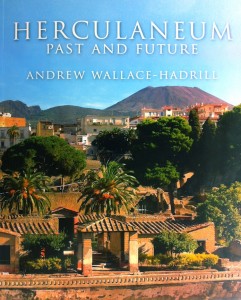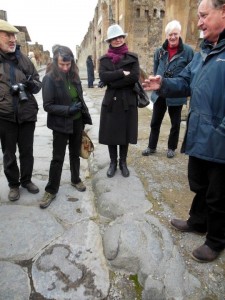Pompeii buffs beware! If you go on a tour with Professor Andrew Wallace-Hadrill your world will be rocked as surely as the Pompeians were rocked on several occasions leading up to that fateful day in 79 CE when Vesuvius erupted. Wallace-Hadrill is director of the Herculaneum Conservation Project and author of Herculaneum: Past and Future. Some people call him “Professor Herculaneum”, because few people know Pompeii’s smaller, richer sister-city better.
When Cambridge Alumni Travel in conjunction with Andante Travels offered a once-in-a-lifetime chance to visit ruins on the Bay of Naples with Wallace-Hadrill I jumped at the chance. I had visions of him telling us things no book would reveal and taking us places no tour guide would have access to. I was right. He did get us into places the other tours didn’t reach. But he also demolished some long-accepted facts about the famous eruption of Vesuvius and the ruins it left.
By the end of our first hour with Andrew Wallace-Hadrill I realized he was a Myth Buster extraordinaire. Like all great historians and archaeologists, he does not accept facts just because they’ve been repeated in print a bazillion times. He has a knack for looking at things with fresh eyes and reinterpreting the evidence if necessary.
Here are ten of my most cherished beliefs: BUSTED!
Myth #1 – Vesuvius did not erupt on 24 August AD 79. Everybody confidently quotes this as the date of the eruption, but everybody is probably wrong! At the turn of the 20th century, everybody claimed the eruption occurred in November. But Wallace-Hadrill thinks late September or early October is a likelier date. His clue is a lot of ripe pomegranates found near a buried villa at a place called Oplontis between Pompeii and Herculaneum. (This villa is known as the Villa Poppea or Villa Poppaea because it was owned by Nero’s wife Poppaea.) In Italy, pomegranates ripen in late September/early October. The problem is not with Pliny the Younger, whose famous letters tell us the date of the disaster, but with the monks who interpreted his dates as they copied his manuscripts.
Myth #2 – Villa Poppea not owned by Nero’s Wife. The Villa at Oplontis probably wasn’t called the Villa Poppea and it probably wasn’t owned by Nero’s wife Poppaea. (Though both things might be possible.) Furthermore, the town where it’s located wasn’t called Oplontis. Or maybe it was. We just don’t know.
Myth#3 – population of Herculaneum. Guide books often say the population of Herculaneum was 4,000 people. We simple do not know! Those who hung around were probably vaporized by the first pyroclastic surge. This explains why so few bodies have been found in the town at the foot of Vesuvius. The only bodies we’ve found at Herculaneum were those sheltering deep underground or in the vaulted boat-houses facing the waterfront. But wait…
Myth #4 – not boat-houses. The famous bone-filled “boat-houses” in Herculaneum probably weren’t boat houses. Yes, they were by the sea but they probably had a double function as foundations for the Suburban Baths and storehouses for various goods, (but probably NOT for boats.) Wallace-Hadrill thinks the dozens of skeletons found there were those of people sheltering from what they believed was just another earthquake. He believes there were dozens of earthquakes in the run-up to the eruption, starting with the big one in 62 CE. But wait…
Myth #5 – the earthquake of 62. The famous earthquake of 62 CE was almost certainly in 63 CE. Scholars got the dating wrong. Tacitus tells us who the consuls were and this allows us to date it precisely.
Myth #6 – buried under hot mud! Herculaneum was NOT buried by hot mud as all the guidebooks tell you. It was buried under alternating layers of tufa (hardened ash) and lapilli (light aerated pebbles of volcanic matter). You can see it before your very eyes if you just look.
Myth #6 – don’t call it a thermopolium. The Romans called those fast-food places popinae or tabernae. The word thermopolium only occurs once in Plautus (a 3rd century BC Roman comic playwright). It was probably a joke word. Wallace-Hadrill, the Myth-Buster, called this a “dubious term”.
Myth #7 – don’t call it the Decumanus Maximus. Romans did not call the main road through town the Decumanus Maximus. That is a term invented by modern scholars. They probably called it Venus Street. Or Street of the Fishmarket, or similar.
Myth #8 – don’t call it a lararium. They might have worshipped Hercules or Diana there, rather than the Lares of the household. Call it a shrine, an aediculum in Latin.
Myth#9 – so-called discovery of Pompeii. Pompeii was not really “discovered” in the 18th century. They knew it was there but just weren’t interested or were discouraged by the church from investigating too deeply.
Myth#10 – the erect male member is not always apotropaic. In Pompeii, guides will tell you that phalluses point the way to brothels. Experts tell you the erect member was a symbol of good luck, used against the “evil eye”. But to bust a busted myth: sometimes the phallus DID point the way to a brothel. (see picture at top, of a phallus on a paving stone of the Via dell’Abbondanza, Pompeii’s main drag.)
 The main thing I learned from our time with Professor Herculaneum was this: There’s a lot we don’t know. Don’t believe things just because you’ve read them or heard them. Always check the primary sources in conjunction with the archaeological evidence and make up your own mind.
The main thing I learned from our time with Professor Herculaneum was this: There’s a lot we don’t know. Don’t believe things just because you’ve read them or heard them. Always check the primary sources in conjunction with the archaeological evidence and make up your own mind.
For those of you not lucky enough to travel to the Bay of Naples with Andrew Wallace-Hadrill as a tour guide, don’t despair. His lavishly-illustrated and clearly-written book, Herculaneum Past and Future, is now out in paperback. I can’t recommend it highly enough.
Caroline Lawrence has written a 17-book series of history-mystery books for children called the Roman Mysteries. Three of the books are set on the Bay of Naples during and after the eruption of Vesuvius: The Secrets of Vesuvius, The Pirates of Pompeii and The Sirens of Surrentum. Find out more at her website: www.carolinelawrence.com

